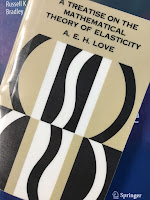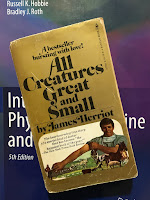 |
| A Treatise on the Mathematical Theory of Elasticity, by A. E. H. Love. |
As with much of my research, our paper on magneto-acoustic imaging addressed a simple “toy model”: an electric dipole in the center of an elastic, conducting sphere exposed to a uniform magnetic field. We were able to calculate the tissue displacement and pressure analytically for the cases of a magnetic field parallel and perpendicular to the dipole. One of my favorite results in the paper was that we found a close relationship between magneto-acoustic imaging and biomagnetism.
“Magneto-acoustic pressure recordings and biomagnetic measurements image action currents in an equivalent way: they both have curl J [the curl of the current density] as their source.”For about ten years, our paper had little impact. A few people cited it, including Amalric Montalibet and later Han Wen, who each developed a method to use ultrasound and the Lorentz force to generate electrical current in tissue. I’ve described this work before in a review article about the role of magnetic forces in medicine and biology, which I have mentioned before in this blog. Then, in 2005 Bin He began citing our work in a long list of papers about magnetoacoustic tomography with magnetic induction, which again I've written about previously. His work generated so much interest in our paper that in 2010 alone it was cited 19 times according to Google Scholar. Of course, it is gratifying to see your work have an impact.
But the story continues with a more recent study by Pol Grasland-Mongrain of INSERM in France. Building on Montalibet’s work, Grasland-Mongrain uses an ultrasonic pulse and the Lorentz force to induce a voltage that he can detect with electrodes. The resulting electrical data can then be analyzed to determine the distribution of electrical conductivity (see Ammari, Grasland-Mongrain, et al. for one way to do this mathematically). In many ways, their technique is in competition with Bin He’s MAT-MI as a method to image conductivity.
Grasland-Mongrain also publishes his own blog about medical imaging. (Warning: The website is in French, and I have to rely on Google Translate to read it. It is my experience that Google has a hard time translating technical writing). There he discusses his most recent paper about imaging shear waves using the Lorentz force. Interestingly, shear waves in tissue is one of the topics Russ Hobbie and I added to the 5th edition of Intermediate Physics for Medicine and Biology, due out next year. Grasland-Mongrain’s work has been highlighted in Physics World and Focus Physics, and a paper about it appeared this year in Physical Review Letters, the most prestigious of all physics journals (and one I’ve never published in, to my chagrin).
I am amazed by what can happen in twenty years.
As a postscript, let me add a plug for toy models. Russ and I use a lot of toy models in IPMB. Even though such simple models have their limitations, I believe they provide tremendous insight into physical phenomena. I recently reviewed a paper in which the authors had developed a very sophisticated and complex model of a phenomena, but examination of a toy model would have told them that the signal they calculated was far, far to small to be observable. Do the toy model first. Then, once you have the insight, make your model more complex.










